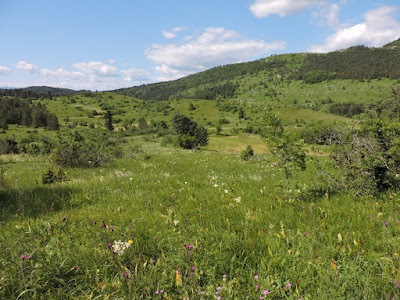 |
| Lilium carniolicum, Nanos, 28th June 2016. Quite frequent species on the sunny, grassy slopes of mount Nanos, but still, always a thrill to see. This species got its name from Carniola (historical region of Slovenia) and is also present in other parts of the country, usually favouring sunny, open areas on a higher elevation. |
 |
| Lush meadows on Nanos plateau, 28th June 2016. With Filipendula vulgaris, Gladiolus illyricus, Cirsium pannonicum, Rhinanthus sp. ect. A real spectacle with tens of different colorful species. |
 |
| Gladiolus illyricus, Nanos, 28th June 2016. Common on Nanos where it can form nice pink "carpets" in the late-spring grass. |
 |
| Satyrium spini, Nanos, 28th June 2016. |
 |
| Astragalus carniolicus, Nanos, 28th June 2016. Nanos is the locus typicus of this species that is quite frequent among limestone rocks. |
 |
| Rocky ridge near Nanos' top and forested hills separating the Karst from the Vipava valley, 28th June 2016. |
 |
| Genista sericea, Nanos, 28th June 2016. In full bloom now on the most sunny rocky spots on Nanos (especially around the summit). Can form large yellow cushions, visible at a long distance. |
 |
| Steep grassy slope close to the summit, Nanos, 28th June 2016. A quite hostile, wind-swept environment, but still, full of interesting forms of life. Lilium carniolicum here is very common and Rock Thrush Monticola saxatilis breeds among the rocks. |
 |
| Alpine Chamois Rupicapra rupicapra, Nanos, 28th June 2016. Three young individuals in summer coat. Chamois is frequently seen resting on the limestone screes or sometimes grazing the lush green meadows on the plateau. |
 |
| Rosa sp., Nanos, 28th June 2016. |
 |
| Sempervivum tectorum (rosette - leaves), Nanos, 28th June 2016. Common species of houseleek, found throughout Slovenia; on the karstic limestones can be really abundant. |
 |
| Traunsteinera globosa, Nanos, 28th June 2016. Quite frequent species on mountain meadows, along with the very common Gymnadenia conopsea. |
 |
| Iris sibirica ssp. erirrhiza, Nanos, 28th June 2016. Unlike the nominate subspecies sibirica, which is found in wet, lowland areas, the endemic ssp. erirrhiza (or "Kojnik's Iris") is a plant of dry grasslands. It grows commonly on Nanos, Banjščice & Snežnik plateaus and Čičarija - where on mount Kojnik has its locus typicus. |
 |
| Allium victorialis, Nanos, 28th June 2016. Scarce montane species that blooms later than Allium ursinum and is usually commoner in the Alps. |
 |
| Coenonympha arcania, Nanos, 28th June 2016. Very common butterfly these days. Some brambles (Rubus sp.) had tens of specimen resting on the leaves. |
 |
| Roe Deer Capreolus capreolus (two males), Nanos, 28th June 2016. |
 |
| Coenonympha oedippus, Karst near Trieste, 29th June 2016. My friend Paul Tout showed me this one, close to his garden, on the Karst. On a small clearing in scrubby habitat, a few specimen emerge every season, at this time of year. C. oedippus is usually found on wet meadows and bogs, but a population on the Karst (in Slovenia, Italy and Croatia) inhabits dry grassland areas. The above specimen thus belongs to the "dry grassland ecological type". It is a rare species in Slovenia and overall declining in Europe, due to habitat loss. Also Natura 2000 species. |
The other day I spent the afternoon on the beautiful grassy slopes of mount Nanos and waited the sunset on a rock. In the evening I was quite surprised to hear a Corncrake Crex crex singing a couple of times. The habitat up there looks good for them, but as far as I know, no breeding population is present. It may happen that from time to time one or two males stop on migration and hold "empty territories" for a season. Also around in the evening were several singing Nightjars Caprimulgus europaeus.
























